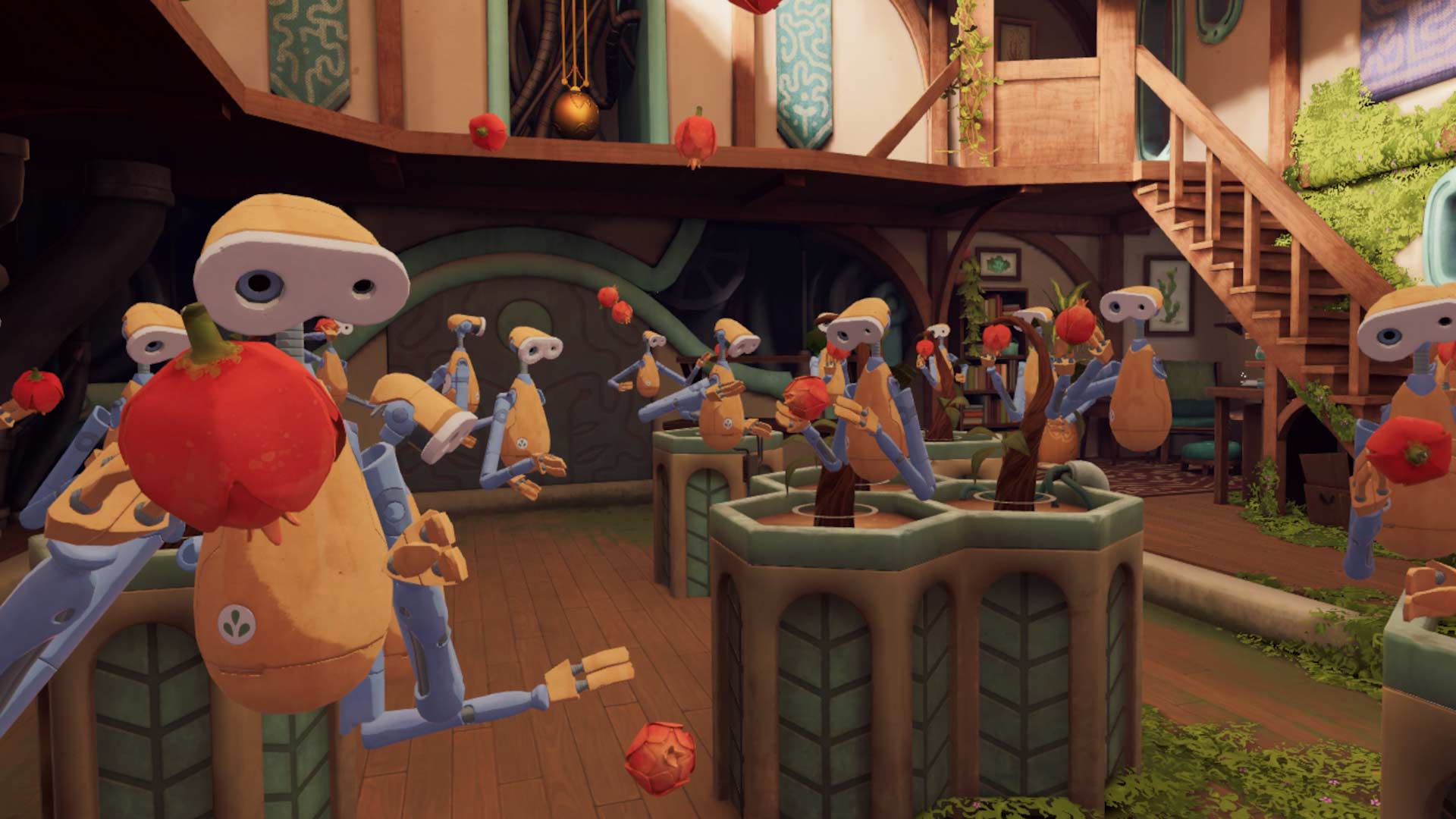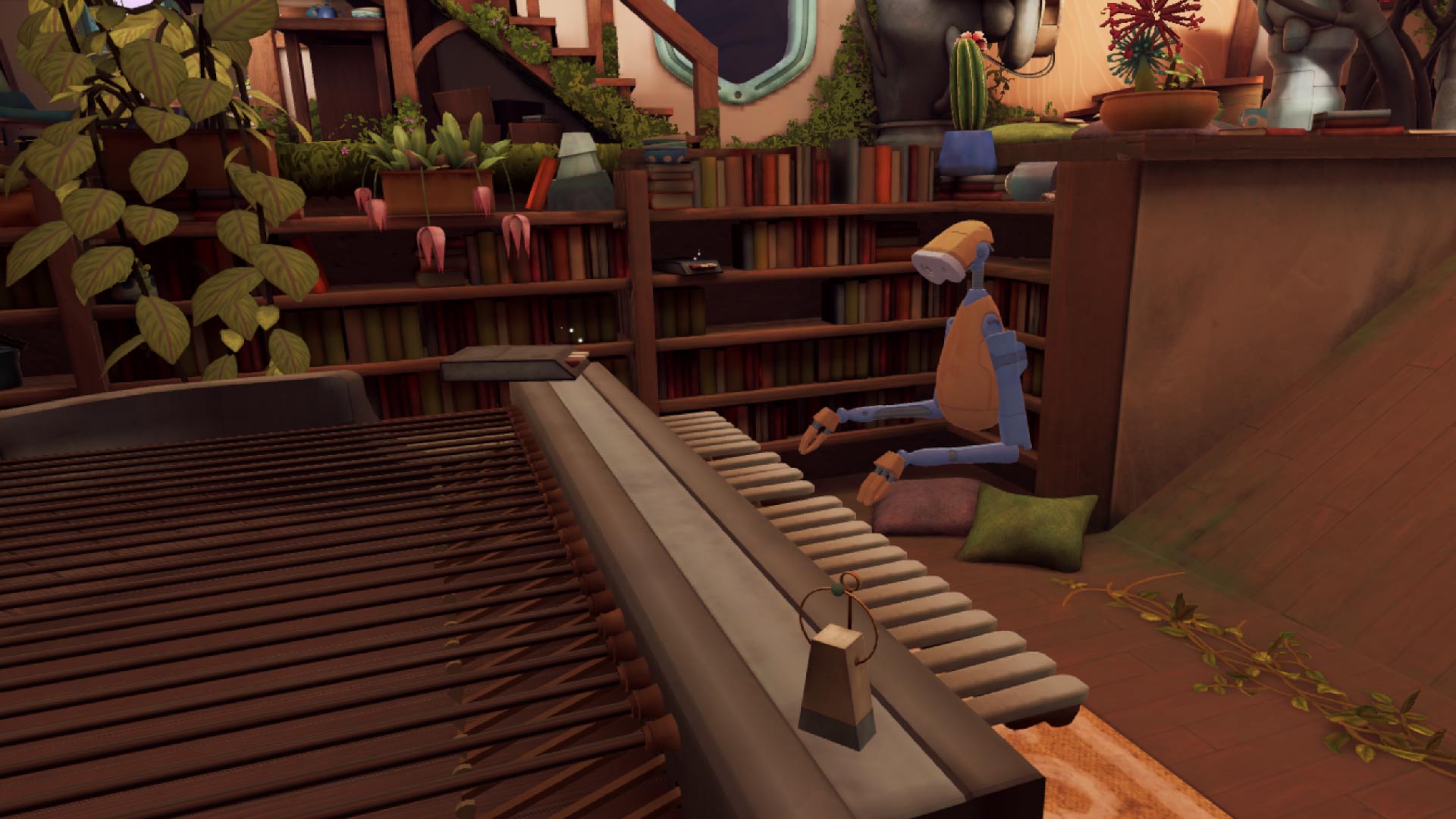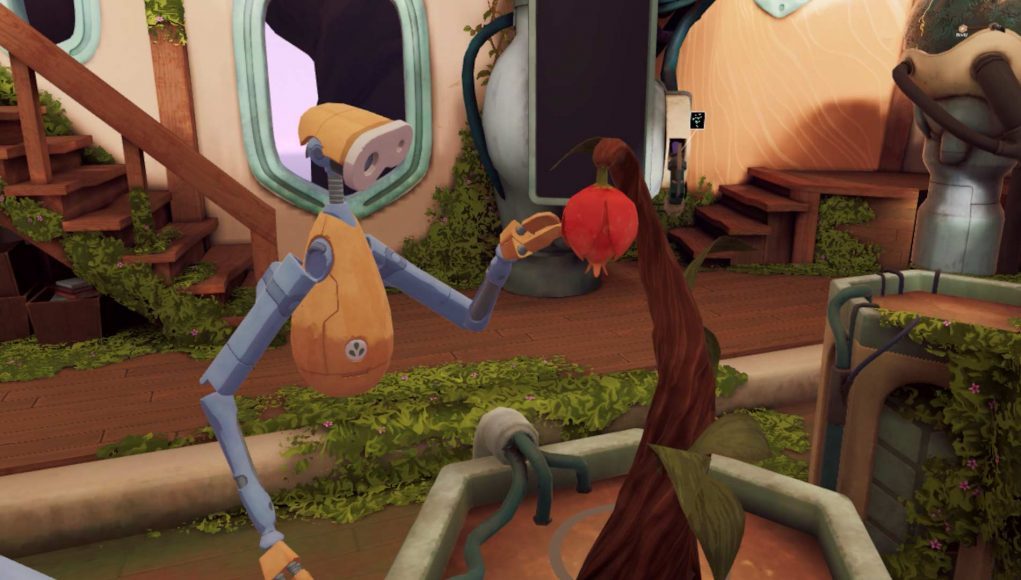The Last Clockwinder is casual puzzle game that tasks you with building moving contraptions out of your own clones. While constructing complex factories essentially populated by just yourself is good fun, the game also excels in delivering a world that feels alive, which isn’t an easy task when you’re basically (ok, not exactly) in one room the entire game with a bunch of automatons picking fruit and pumping levers. Thanks to its seemingly Studio Ghibli-inspired setting and series of audio logs which tie it all together with a heartfelt story, The Last Clockwinder makes for a charming little adventure that may just pull a heartstring or two.
The Last Clockwinder Details:
Available On: Quest, SteamVR
Release Date: June 2nd, 2022
Price: $25
Developer: Pontoco
Publisher: Cyan Ventures
Reviewed On: Quest 2
Gameplay
Humans have become a multiplanetary species, but even with our space ships and fun steampunk-style gadgetry, someone has to watch over the ancient clocktower built into the trunk of a colossal tree growing on a watery planet. The massive water pump inside is broken, and if you don’t fix it the universe could lose an irreplaceable landmark from centuries past as the tree becomes increasingly waterlogged and the rare plant life inside could perish. The tree-bound clocktower and the fate of its caretaker is a mystery worth unraveling, so I won’t say anymore for the sake of spoilers.
Entering the tower from its balcony, you find a pair of gloves that let you record your actions and loop them so you can complete more complex tasks. Creating an automaton is pretty effortless: a button press on your left controller lets you start recording your movements for a set amount of time—a duration of one, two, or four cycles—and another button lets you delete any bot you deem unworthy. I found it best to mimic each action first and work through the chain of events before committing to recording and setting the bots in motion. That said, you’ll still find yourself spawning and killing a lot of bots as you inevitably biff a critical throw or mess up timing on a catch.

There’s likely an effective limit to how many robots you can spawn, but that’s not really the focus. If you’re like me, you’ll obsess over recording perfect automaton behavior, like slicing a fruit from its base, handing the fruit and knife simultaneously to two different robots, and letting them do their chain of events. There’s a lot of satisfaction there when you can get those complex bits to come together just in the nick of time.
Ultimately the aim is to feed machines with the auto-generating fruit you find hanging off plants discovered throughout the game, and all of them have their own unique characteristics. A bomb fruit explodes if you hold it in your hand for too long, making it a game of hot potato. A squash-thing (whatever it’s called) needs to be cut from its base to be released and—you guessed it—there’s only one knife to go around. A Luftapple floats into the air like a balloon, so you have to knock it about and guide it into its receptacle, or it will fly off with a mind of its own. Here’s a good visual of how you might juice the game’s starter fruit:
I call The Last Clockwinder a ‘casual’ puzzler because the speed of production is up to you. The assembly line can be simple and slow, or increasingly Rube Goldberg-ian to max out the amount of fruit you can process. As puzzles become more complex, you’ll certainly be tempted to keep it simple though since setting up an entire chain of events can help you increase production, or make you pull your hair out trying to get just the right arch as you pitch a fruit halfway across the room. Interspersed throughout the fruit-gathering sections, which make up a bulk of the game, are a few one-off puzzles that present what I’d consider a medium difficulty level.
Optimizing your ad hoc factory for the fastest possible processing speed is an optional part of the game, since you can get by with just waiting for your tally of each of the fruits to go up at a slower speed provided you don’t mind bebopping around. You’ll need each of those fruits in abundance to unlock areas on the globe-shaped map, which lets up call up and plug in room-sized platforms held within the tree itself.
Don’t get me wrong: it’s not too casual of a puzzler. Near the end, which took me around four hours to reach, there are some genuinely complex puzzles to navigate. Really reaching for max efficiency on each room puzzle will no doubt add extra value to your gameplay session, provided you like to get into the nitty gritty of streamlining systems. Eg. have a robot cut a squash, toss a knife, and deposit the squash from half court. But again, you can always get by with the bare minimum.
And while you could play the game ‘easy’, it doesn’t treat you like you can’t follow basic instructions. One of my pet peeves is being led by the hand to solutions and ‘helpful’ voices over your shoulder, but thankfully the game doesn’t over tutorialize or butt in when it isn’t wanted. Voice overs are almost purely focused on delivering narrative, leaving you to ask for hints when needed via a single mechanism that gives you push in the right direction. You can take it or leave it, and I like that.
I also never felt like there was a down moment in The Last Clockwinder. Most rooms (not all) present a different puzzle, fruit, or fruit product to navigate, so the variability of tasks is pretty high. And those tasks build upon each other naturally until you get to the most complex machine near the end of the game which requires you to put all of your knowledge together in a satisfying way, making you feel like you’ve learned something and effectively used that skill to good effect.
Immersion
There’s no arguing that the world of The Last Clockwinder is small; it’s a multi-purpose room in a tree that you never leave. But it’s also such a cozy and familiar environment that I don’t think I would want to even if I could. It’s like the cool treehouse hangout I always wanted as a kid, but way more sci-fi and steampunkish than I ever could have imagined. I definitely left with the feeling of wanting more: a broader outdoor vista, better object interaction, and more narrative byways to get lost in, like books and messages that help fill out the story, if only to soak in all of the game’s expertly-crafted atmosphere.
That’s a wishlist, I know, but if I could really have one thing it would be better object interaction, or at least a better expectation of object interaction. I see tomes in front of me I want to read, chairs I want to sit in, and things I wish I could (pretend to) eat, yet the only interactive elements are the fruit and the machines themselves, leaving all of those painstakingly built set pieces a little more transient and less solid than they ought to be. That’s not such a damning thing when a good game is behind it all, although it’s just a shame I can’t inhabit more of The Last Clockwinder. That’s how beautiful and inviting the game feels.

Outside of impeccable visual detail, the game also includes high quality voice acting which is delivered via balcony-based comm system and tape recorders littered throughout the many rooms. Those narrative bits are numerous and triggered at key points in the game, but well worth your time as the mystery of who you are (or were) unfolds.
Another high point is sound design. The game’s piano-heavy soundtrack is warm and rich, underlining the cozy and homey feel of it all. To top it off, the game even challenges you to play the main tune, if only to wring some more fun out of the game’s looping mechanic. I could play the piano (keys are actually large enough to use) and the harp for a good while.
In the end, it certainly feels like the game’s developers, Pontoco, have taken strong inspiration from the likes of Studio Ghibli. That’s an ambitious target to shoot for, but I think they’ve built something that recalls so much of that quiet and honest home-spun charm whilst being distinct enough on its own that it doesn’t make the same mistake that many games do when aping such an iconic visual style.
Comfort
This may come as a shock in this day and age, but this is a teleport-only game which consequently also makes it one of the most comfortable of VR games out there.
You spend a good amount of time moving about back and forth to the same places, so it does save you a bit of time moving from point A to point B, although this does come at the cost of immersion. You can also snap-turn if you like playing seated, although this sort of game begs for room-scale interactions. There’s no artificial locomotion to speak out outside of those methods, since you’re essentially staying in a single room the entire time.
The Last Clockwinder – June 2nd, 2022 |
|
Turning |
|
| Artificial turning |  |
| Smooth-turn |  |
| Snap-turn |  |
| Adjustable increments |  |
Movement |
|
| Artificial movement |  |
| Smooth-move |  |
| Teleport-move |  |
| Blinders |  |
| Swappable movement hand |  |
Posture |
|
| Standing mode |  |
| Seated mode |  |
| Artificial crouch |  |
| Real crouch |  |
Accessibility |
|
| Subtitles |  |
| Languages | English |
| Alternate audio |  |
| Languages | English |
| Adjustable difficulty |  |
| Two hands required |  |
| Real crouch required |  |
| Hearing required |  |
| Adjustable player height |  |







